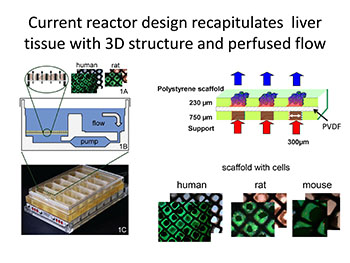


Posted April 23, 2013
Alan Wells, M.D., University of Pittsburgh, Pittsburgh, Pennsylvania
Linda Griffith, Ph.D., Massachusetts Institute of Technology, Cambridge, Massachusetts
 Metastatic cells can escape the primary breast tumor and lie dormant in distant organs for years. The triggers for the "re-awakening" of these micrometastases are not well understood. The liver is a major site of metastatic spread for breast cancer. To understand which tumor cell behaviors contribute to metastasis and disease progression in the liver, Dr. Wells and Dr. Griffith developed a three-dimensional ex vivo organotypic tissue system with funding from a Fiscal Year 2003 (FY03) Idea Award. This bioreactor allowed liver cells to grow in a device outside the body, while preserving and recreating the behaviors of living tissue, thus allowing the process of seeding, dormancy, and emergence to be followed. With subsequent funding from a FY09 Idea Expansion Award, Dr. Wells and Dr. Griffith are using this model to gain an understanding of what triggers dormant breast cancer cells to emerge, ultimately building the foundation for the development of therapeutics or prevention strategies.
Metastatic cells can escape the primary breast tumor and lie dormant in distant organs for years. The triggers for the "re-awakening" of these micrometastases are not well understood. The liver is a major site of metastatic spread for breast cancer. To understand which tumor cell behaviors contribute to metastasis and disease progression in the liver, Dr. Wells and Dr. Griffith developed a three-dimensional ex vivo organotypic tissue system with funding from a Fiscal Year 2003 (FY03) Idea Award. This bioreactor allowed liver cells to grow in a device outside the body, while preserving and recreating the behaviors of living tissue, thus allowing the process of seeding, dormancy, and emergence to be followed. With subsequent funding from a FY09 Idea Expansion Award, Dr. Wells and Dr. Griffith are using this model to gain an understanding of what triggers dormant breast cancer cells to emerge, ultimately building the foundation for the development of therapeutics or prevention strategies.
The bioreactor system was successful in creating a soft gel scaffold format of desirable biological properties to seed tumor cells. The demonstrated maintenance of liver tissue function in these structures enabled the study of the microenvironment surrounding dormant micrometastasis. Dr. Wells and Dr. Griffith discovered that tumor cells produce inflammatory cytokines that cause normal liver cells to break their cell-cell attachments and enable tumor cells to intercalate between normal cells and reside. When the environment surrounding the dormant cells is induced, for example, via liver parenchymal stress, growth factors capable of relieving the resident tumor cells from suppression are produced. Moreover, as these tumor cells escape dormancy and proliferate, their oxygen uptake increases. To advance the development of the bioreactor, Dr. Wells and Dr. Griffith were able to optimize an approach for measuring oxygen, serving as a highly informative means of assessing tumor cell proliferation.
The development of the bioreactor, armed with enhanced controls and oxygen measurements, represents a unique and relevant model of micrometastatic dormancy and emergence ex vivo. The advances from this project set the stage for a National Institutes of Health-funded project involving groups from Draper Laboratories and a commercial entity, Zyoxel, committed to developing the bioreactor for widespread usage. This new project is one of 17 Tissue Chip Project Awards awarded by the National Institutes of Health National Center for Advancing Translational Sciences. The proposed work focuses on further understanding the complexity of the tumor microenvironment in cancer metastasis and developing the next-generation all-human liver bioreactor, allowing for greater advances in breast cancer drug and therapy development.

Links:
Public and Technical Abstracts: An Organotypic Liver System for Tumor Progression
Public and Technical Abstracts: Escape from Tumor Cell Dormancy














